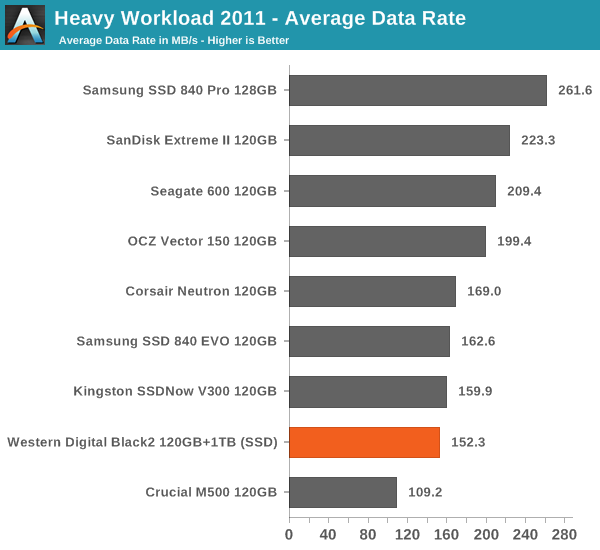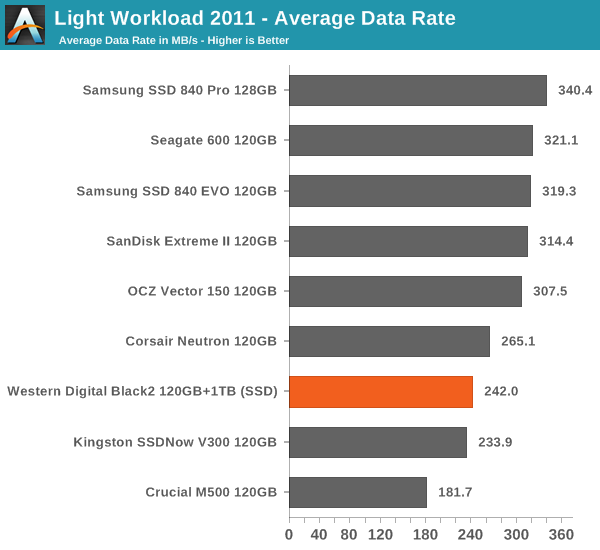The WD Black2 Review: World's First 2.5" Dual-Drive
by Kristian Vättö on January 30, 2014 7:00 AM ESTAnandTech Storage Bench 2011
Two years ago we introduced our AnandTech Storage Bench, a suite of benchmarks that took traces of real OS/application usage and played them back in a repeatable manner. The MOASB, officially called AnandTech Storage Bench 2011 - Heavy Workload, mainly focuses on peak IO performance and basic garbage collection routines. There is a lot of downloading and application installing that happens during the course of this test. Our thinking was that it's during application installs, file copies, downloading and multitasking with all of this that you can really notice performance differences between drives.
We tried to cover as many bases as possible with the software incorporated into this test. There's a lot of photo editing in Photoshop, HTML editing in Dreamweaver, web browsing, game playing/level loading (Starcraft II & WoW are both a part of the test) as well as general use stuff (application installing, virus scanning). We've included a large amount of email downloading, document creation and editing as well. To top it all off we even use Visual Studio 2008 to build Chromium during the test.
The test has 2,168,893 read operations and 1,783,447 write operations. The IO breakdown is as follows:
| AnandTech Storage Bench 2011 - Heavy Workload IO Breakdown | ||||
| IO Size | % of Total | |||
| 4KB | 28% | |||
| 16KB | 10% | |||
| 32KB | 10% | |||
| 64KB | 4% | |||
Only 42% of all operations are sequential, the rest range from pseudo to fully random (with most falling in the pseudo-random category). Average queue depth is 4.625 IOs, with 59% of operations taking place in an IO queue of 1. The full description of the test can be found here.
AnandTech Storage Bench 2011 - Heavy Workload

AnandTech Storage Bench 2011 - Light Workload
Our light workload actually has more write operations than read operations. The split is as follows: 372,630 reads and 459,709 writes. The relatively close read/write ratio does better mimic a typical light workload (although even lighter workloads would be far more read centric). There's lots of web browsing, photo editing (but with a greater focus on photo consumption), video playback as well as some application installs and gaming.
The I/O breakdown is similar to the heavy workload at small IOs, however you'll notice that there are far fewer large IO transfers.
| AnandTech Storage Bench 2011 - Light Workload IO Breakdown | ||||
| IO Size | % of Total | |||
| 4KB | 27% | |||
| 16KB | 8% | |||
| 32KB | 6% | |||
| 64KB | 5% | |||











100 Comments
View All Comments
Shadowmaster625 - Thursday, January 30, 2014 - link
What a joke. For $300 you can just buy a 512GB SSD and not have to deal with a 2nd partition that might just decide to disappear at any moment due to its odd driver dependency. There's actually one on sale right now for $260. What is WD smoking?LauRoman - Thursday, January 30, 2014 - link
As i understand it it is not a weird driver dependency. The driver is really only needed to flip a switch that woun't suddenly flip back by itself, even if you destroy the drive's mbr/gpt. It should work in any os after the switch is flipped. I don't know if you need a Windows install to switch it on though.Panzerknacker - Thursday, January 30, 2014 - link
Exactly, that's what I'm thinking as well, the driver is only used to flip a certain switch that's unique in this particular drive. Now that I'm thinking of it they probably did this to help with installing Windows. When installing Windows the installer will only find the 120gb partition, Windows has the strange behaviour of messing around with partitions during installation and putting system stuff on other partitions. Normally you can disconnect the other drives in the system, not on this one ofc because it's 2 in 1. Then when everything is installed you can enable the other partition with the switch triggered by the driver.I'd wonder how you would do this without Windows tho, they should also include a hardware switch.
mikato - Friday, January 31, 2014 - link
I HATE that. Detaching everything but the SSD is standard procedure during Windows installation now because of that. It's a nasty surprise when you decided to take out your hard drive or switch it with another only to find that Windows won't boot now, even when you had installed Windows on the SSD! Do you know if Windows 8 does this?HisDivineOrder - Thursday, January 30, 2014 - link
It's been a long time since WD truly impressed me with a new product.Guspaz - Thursday, January 30, 2014 - link
I've seen the 1TB Samsung 840 EVO go under $500. If you gave me the choice between paying $300 for a slow 1TB HDD with a pretty terrible 120GB SSD, or paying $500 for a fast 1TB SSD, which do you think I'd pick?About the only thing that could make the WD solution interesting is if it offered a substantially more attractive price than the SSD (and "somewhat cheaper" isn't), and if it had the SSD caching solution in hardware so that it could just be plugged in and used as a normal drive.
With a full 1TB SSD costing not much more than this thing, it's not useful for the "notebook with only one 2.5" slot" scenario... or any other scenario.
coolhund - Sunday, February 9, 2014 - link
Exactly. Also keep in mind that SSD prices keep falling and falling, while HDDs still havent gotten back to the prices that we had before that 'flood' and are not really getting cheaper nowadays. And thats why it will fail, just like the hybrid ones. I think it will actually fail even more.mobutu - Thursday, January 30, 2014 - link
Too little, Too lateI mean with very good 1TB SSDs ready to go mainstream at 400-500USD this wd2 is completely useless, especially for all the people that already use SSDs and know what a tremendous impact it has over a hdd dinosaur (performance/power/heat/silence/formfactor) (msata at 1TB already gimme a break must be a joke to look at wd2).
HDDs are close to extinct, it is a matter of time/price until they'll dissapear completely exactly like the FDD ... both are/were huge bottleneck to a system.
chizow - Thursday, January 30, 2014 - link
I thought this was pretty useless when it was announced a few months ago, but with the increasing popularity of SFF and NUC-like devices, this drive would be perfect.Gigaplex - Thursday, January 30, 2014 - link
Or you could just get a 1TB SSD, this drive isn't that much cheaper.